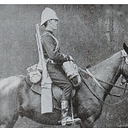Melton Prior. War Correspondent Artist. Anglo Zulu War
Melton Prior (12 September 1845–2 November 1910), was an English artist and war correspondent who in 1879 went out to South Africa to report the Anglo-Zulu War. He arrived in Africa too late to witness the battles of Isandlwana and Rorkes Drift. Still, he was there on the Isandlwana battlefield four months later to witness the burial of the soldiers who had died in that battle. His report brings home the horror that happened on that day six months early on 22 January 1879.
Melton Prior’s report on his visits to the sites in 1879
“At last the hill of Isandlwana came into sight. All glasses were soon out to examine the place, and the wagons were easily seen, still there, not having been taken away by the enemy. As we got closer I started on at a gallop and arrived at the top of the hollow just behind the advance Lancers, and then a sight presented itself that is impossible to describe or to forget.
In all the campaigns I have been in I have not witnessed a scene more horrible. I have seen the dead and the dying on a battlefield by hundreds and thousands, but to come suddenly on the spot where the slaughtered battalion of the 24th Regt and others were lying at Isandlwana was appalling. Here I saw not the bodies, but the skeletons, of men whom I had seen in life and health, some of whom I had known well, mixed up with the skeletons of oxen and horses, with wagons overthrown on their sides, all in the greatest confusion, showing how furious had been the attack by the enemy. Amidst the various articles belonging to our men, and now scattered over the field of carnage, were letters from wives at home to their husbands in the field, from English fathers and mothers to their sons. portraits of babies and children…..
I picked up a cigarette paper book with Coghill’s signature in it, also a letter from Mrs Melville telling her husband how her little boy kept asking when papa was coming home, and then one from his father so full of affection that I could not help the tears coming into my eyes when I thought how he was lying a skeleton above Refugee’s Drift. Strangely enough, I found a letter from Lieut Coghill to Melvill and these two poor fellows lying side by side….
My boy picked up an assegai out of a white man’s skull, it was in the mouth and had pinned him to the ground. The 2nd 24th drum was found, and the flag-staff, but alas the colours were gone, the colours which these gallant officers Coghill and Melvill had …tried to save.
Skeletons of men lay on the ground bleaching under a tropical sun…The individuals could only be recognised by such things as a ring on a finger bone, a knife or a letter, an armlet or a neck chain (which is considered a fetish, the Zulus would not touch). The identification could only be made with much difficulty…..the claws of the vultures tearing up the corpses, had in numberless cases, so mixed up the bones of the dead that the skull of one man, or bones or leg or arm, now lay with parts of the skeleton of another. The Lancers went about all over the field, often here and there lifting the clothes off the skeletons, or gently pushing them aside with their lances to see what regiment they belonged to. I almost regretted to see this done, for it seemed like sacrilege, yet it was the wiser course to run than the risk of blood poisoning by touching the bodies with the hands, and those hands mostly troubled with Natal sores.
All this time scouting parties had been firing the Zulu kraals all around…while other parties were engaged in hitching the spare horses that had been brought with the column onto some 40 wagons and water carts, which were sufficiently fit to travel, and these having been started under escort, the return march was commenced. and we returned to Rorke’s Drift tired and weary, not only on account of the twenty-five miles of country we had traversed but because of the mournful and melancholy sights we had seen.”
All photos used to illustrate these excerpts are from the archives of the Talana Museum.
In this enlarged photo, you can see that the soldier is holding a spade and not a rifle
